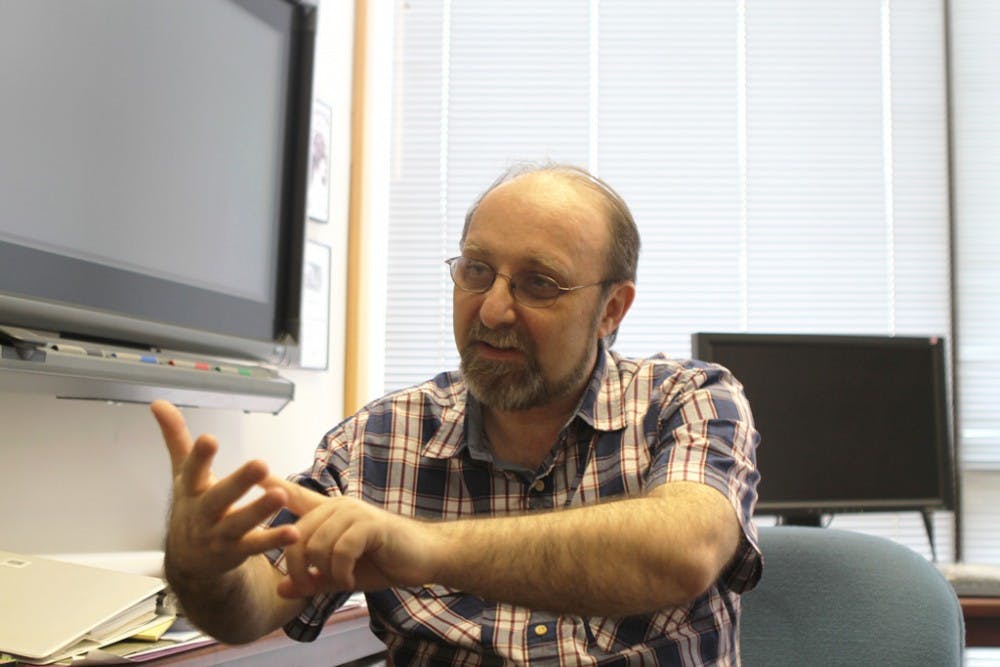A monkey sauntered on a treadmill in Durham and half-way across the world a robot sprang into motion.
Sitting cross-legged in his office chair, Dr. Miguel Nicolelis holds the tiny chip that both connected these two acts and landed him a spot on John Stewart’s “The Daily Show” in March. The chip is called a brain-machine interface—a term he coined himself—and it records and relays neural activity in the monkey’s brain to move a robot in Japan.
This research could one day enable paralytics to walk using a robotic suit operated by the mind.
“It is the big revolution that was created here—in this lab that we are still in today,” said Nicolelis, who is the co-director of the Duke Center for Neuroengineering and Anne W. Deane professor of neurobiology and associate professor of biomedical engineering.
Although Nicolelis performed his first experiments on rats, he made a major breakthrough in 2000 when he began researching brain-machine interface using monkeys. After conditioning the monkeys with rewards to imagine moving without actually doing so, Nicolelis saw that the chip was able to translate the thought of movement to the actual movement of a robot.
“We designed ways to record electrical signals of hundreds of cells simultaneously,” Nicolelis said. “These signals are sent to computers that can extract [their] motor commands and transform them into digital commands that a robot can understand.”
Nicolelis and his team of researchers are currently in the process of building exoskeletals, which are robotic suits that can receive signals from the body machine interface. The idea is that when a paralyzed person thinks of walking, information is relayed from the chip to the suit, enabling them to walk.
“When you’re paralyzed, you can still plan the movements in your head, but the signals cannot go to the muscles because there is a legion in your spinal cord that does not allow the electrical messages to go through,” he said. “It’s as if the cables have been severed—the idea is to capture these [messages] that contain the plans to move … send them to the vest and carry the paralyzed body under the control of the brain.”
Peter Ifft, a third-year in the biomedical engineering graduate program, said there are numerous ways brain-machine interfaces can influence daily life.
“The biggest advantage of brain machine interface is that it helps people who don’t have mobility,” said Ifft, who contributed to the study. “For those who can’t feed themselves and don’t have limb use, the quality of life can be greatly improved.”
Researchers are using brain-machine interface to better understand the workings of the brain, Nicolelis added.
“We discovered that the adult brain is very plastic,” he said. “If a monkey loses a finger in a fight, according to the old theory, those neurons that are related to the finger [are gone]. It turns out that as time goes on, the entire area reorganizes to respond to the other fingers.”
Nicolelis and his team of researchers have found that the brain-machine interface also increases users’ reaction time. The study that transfers electrical brain signals from a monkey walking on a treadmill at Duke to a robot in Japan found that the robot walked 20 milliseconds faster than the monkey.
Because reaction time is improved with the chips, Ifft noted that they can be incorporated to improve safety in vehicle control. Their effect on reaction time could even be beneficial to athletes.
Overall, experts have noted how Nicolelis has transformed the field.
“[Neuroscience] was a conservative field where neurophysiologists would take one electrode, insert it into the brain, get one cell recorded and be very proud,” said study co-author Mikhail Lebedev, a senior research scientist in neurobiology at Duke. “Miguel said ‘Why record one electrode when we can record 100?’”
Nicolelis said that his research, in the most basic sense, is like having telekinesis.
“You cannot get energy out of your head directly,” he said. “But now, if you put a microchip in [your head] and amplify the signal as a radio wave, you can. It’s what people call telekinesis—it’s not naturally given, it’s enhanced by microelectronics, but now it’s real.”
Get The Chronicle straight to your inbox
Sign up for our weekly newsletter. Cancel at any time.

